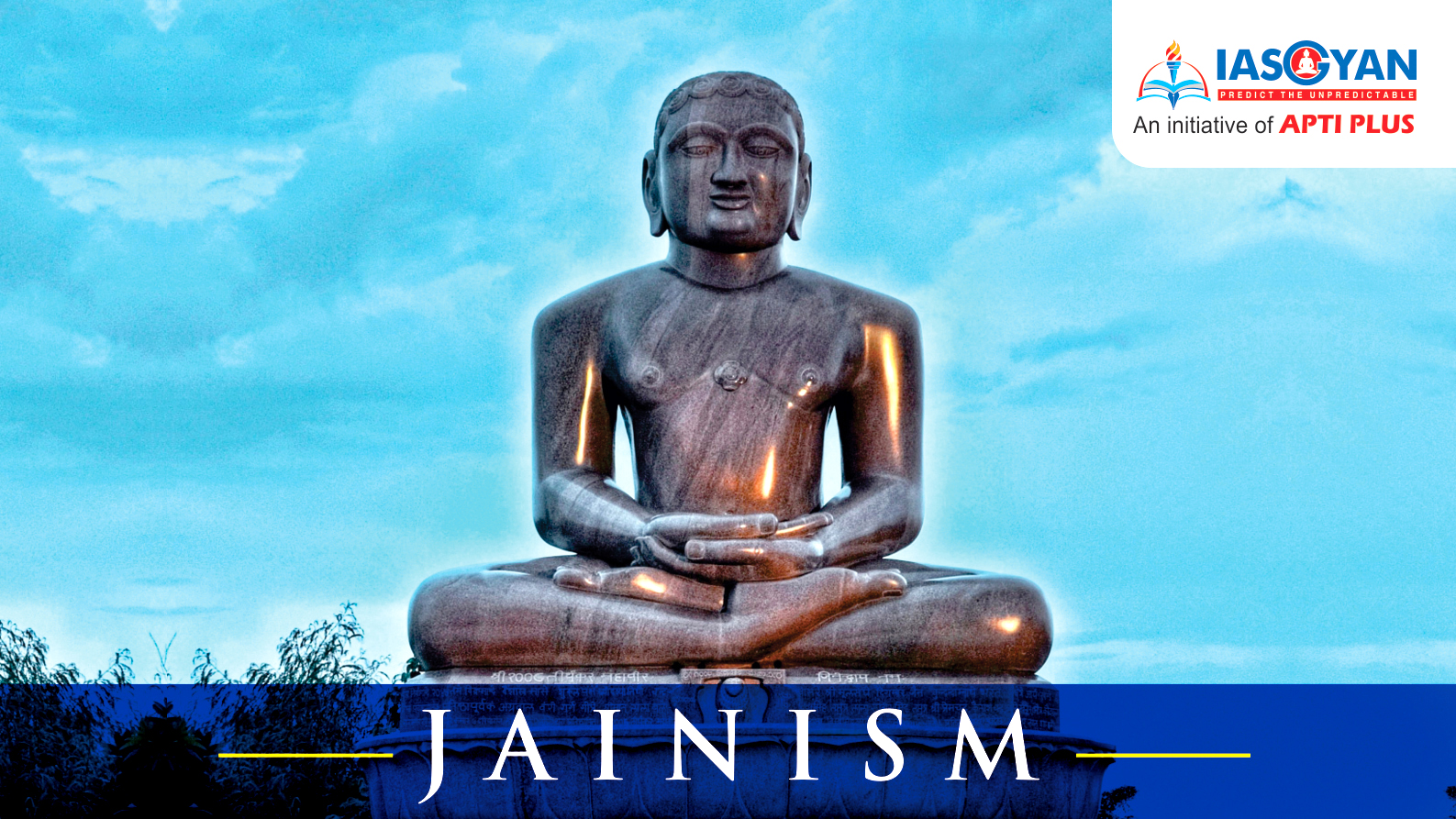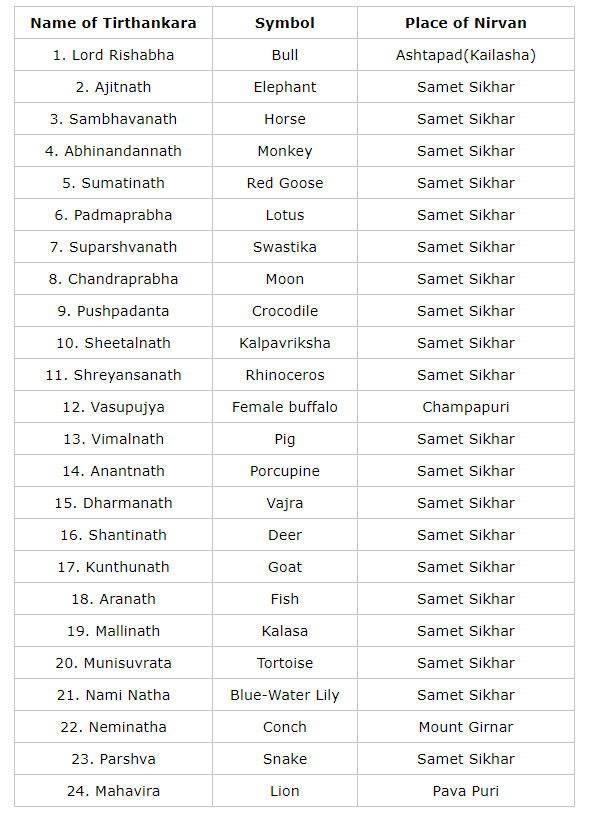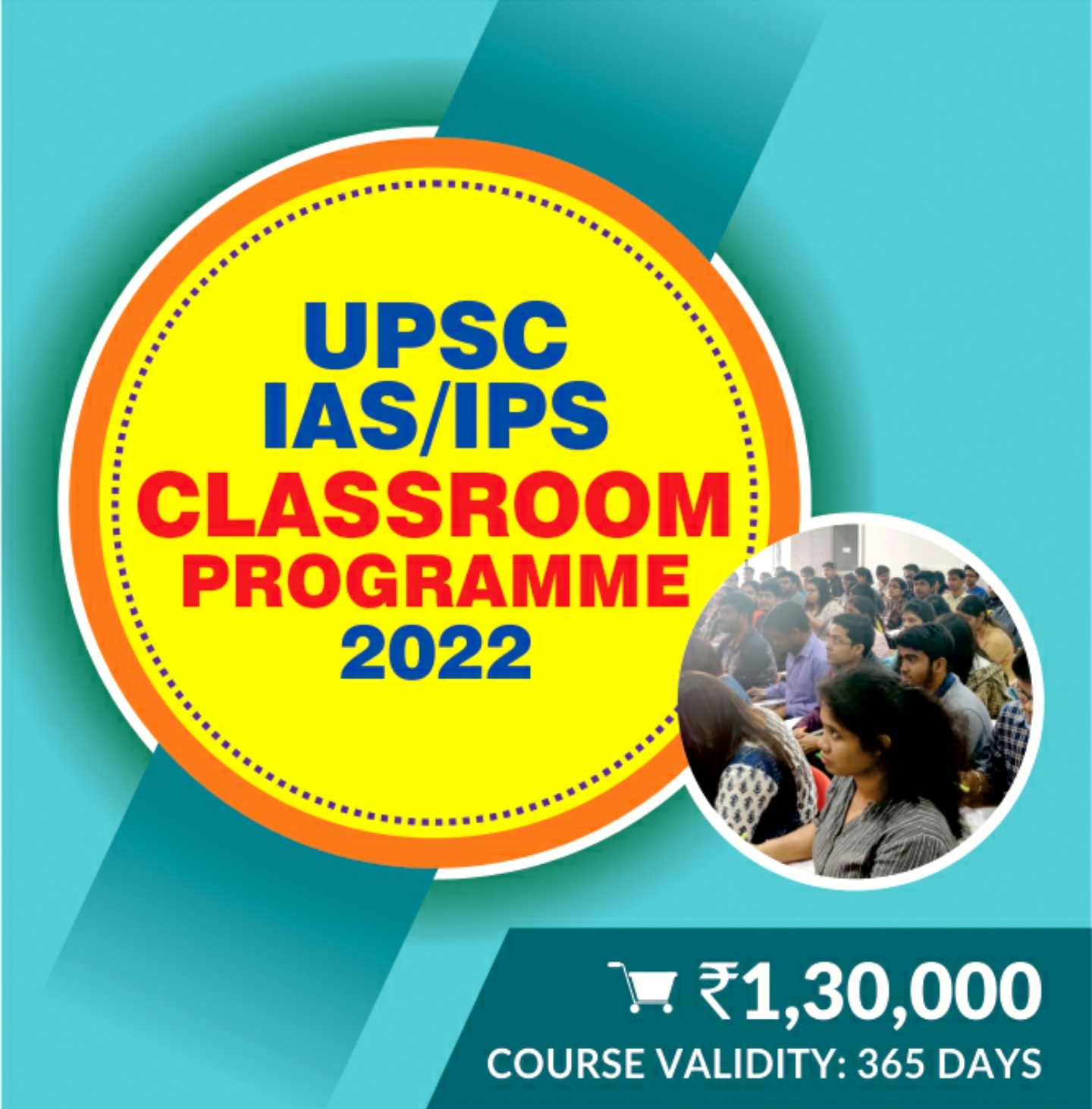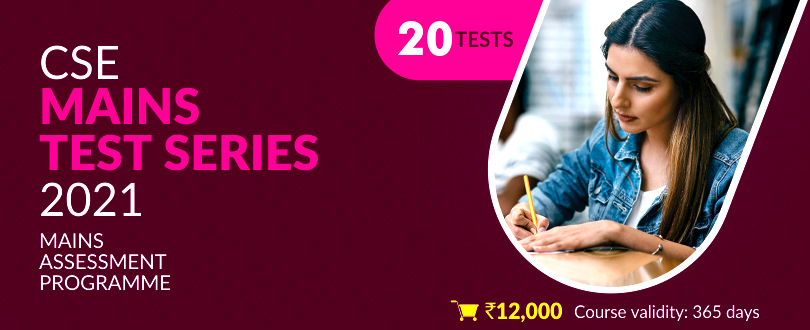
Note: In this article, points which are mostly not mentioned in standard books will be covered. Please go through the basics of the topic like Life of Mahavira from Ancient History Book.
Jainism
- Ancient Religion and its name derives from the word Jina, meaning 'liberator' or 'victor', referring to spiritual rather than material conquest.
- Jains revere a group of 24 liberated souls called Jinas or Tirthankaras who act as teachers and role models to the faithful.
- Jain Canonical was established at the Council of Valabhi, presided over by Devardhi around 454 C.E.
- Jains consider the primary scripture to be the Tattvartha Sutra, or Book of Realities, written over eighteen centuries ago by the monk-scholar Umasvati (also known as Umasvami).
- Jainism does not accept the authority of the Veda.

Sects
- Jainism has two main variants: Digambar (the naked) and Shvetambar (wearers of white cloths).
Origin
- The two major sects of Jainism, Digambar and Shvetambar, trace their origin to events that occurred about two hundred years after the nirvana of Mahāvīr.
- Bhadrabahu, chief of the Jain monks, foresaw a period of famine and led about 12,000 people to southern India.
- Twelve years later, they returned to find that the Svetambar sect had arisen.
- The followers of Bhadrabahu became to be known as the Digambar sect.
- There was no clear division until the 5th century, when the Valabhi council of 453 resulted in editing and compilation of scriptures of the Svetambar tradition.
Difference between Svetambara and Digambara:
(1) Liberation of Woman:
- Digambara believes that women cannot achieve nirvana or liberation directly. They first have to reborn as a man for this.
- Svetambara, on the other hand, have a different opinion. According to them, women are equally capable of achieving liberation as a man. They believe in Sabastra Mukti.
- They believe that anybody can achieve salvation, be it a householder or a monk.

(2) Dress Code:
- Digambara believes that in order to achieve nirvana or liberation, one must renounce everything including clothes. Therefore Digambara monks are completely naked.
- Svetambara, on the contrary, believes that practice of nudity is not essential to attain liberation. Therefore they wear white clothes.
(3) Possessions:
- Digambara monks are not allowed to have any kind of possessions.
- They believe that it is necessary to renounce everything to lead the life of a true monk.
- However, they usually carry three things with them:
o Picchi – broom made up of fallen feathers of a peacock. They use this broom to remove small insects without harming them.
o Kamandalu – oblong water pot used for carrying pure and sterilized drinking water.
o Shastra – scriptures.
- Svetambara monks are allowed to possess 14 specified things, which include:
o White clothes
o Rajoharaṇa – broom made up of soft white wool attached to a wooden handle. Using this they remove small insects from their path without harming them.
o Begging bowl
o Books etc.
(4) Idols:
- Svetambara idols of Tirthankars are decorated with jewels, wearing loincloth with prominent staring eyes.
- However, Digambara idols are naked, undecorated with downcast eyes.

(5) Scriptures:
- In Jainism, the discourse delivered by Tirthankaras is known as ŚhrutJnāna. It comprises of 11 Angas and 14 Purvas.
- Digambara holds the opinion that original texts of Jainism were lost ago.
- Svetambara believe that they have the original Jain scriptures. However, they also accept that their collection is also incomplete.
- Tattvartha Sutra is the most authoritative text in Jainism, accepted by both Svetambara and Digambara.
Jain Literature
- Jain literature is classified into two major categories:
Agam Literature
- This consists of original scriptures complied by Gandharas and Srut-kevalis.
- They are written in the Prakrit language.
Non-agam Literature
- This consists of commentary and explanation of Agam literature and independent works, complied by elder monks, nuns, and scholars.
- They are written in many languages such as Prakrit, Sanskrit, Old Marathi, Gujarati, Hindi, Kannad, Tamil, German, and English.

Agam Literature
- Lord Mahavir's preaching was methodically compiled by his followers into many texts.
- These texts are collectively known as Agams, the sacred books of the Jain religion.
- Hence, the Jain religion does not have one sacred book like the Bible or Koran, but it has many books complied by many followers.
|
There are 41 Sutras, including 11Angas, 12 Upāngas, five Chedas, five Mǖlas, and eight miscellaneous works; a number of Prakirnakas (unclassified works); 12 Niryuktis (commentaries); and the Mahābhāsya, or great commentary.
|
Agam literature is also divided into two groups
- Ang-agams or Ang-pravista-agams: These texts contain the direct preaching of Lord Mahavir. They were compiled by
- Ang-bahya-agams (outside of Ang-agams): These texts are expansions of Ang-agams. They were compiled by Srut-kevalis.
- Ang-agams
- Lord Mahavir's immediate disciples were known as Ganadharas.
- All Ganadharas possessed perfect knowledge (keval-jnan).
- They orally complied the direct preaching of Lord Mahavir into twelve main texts (sutras). These texts are known as Ang-agams.
- Hence the Ang-agams are the oldest religious scriptures and the back bone of Jain literature.
- The twelfth Ang-agam is called Drastivad. The Drastivad consists of fourteen Purva texts, also known as Purvas or Purva-agams.
- Among Ang-agams, Purvas were the oldest sacred texts.
- All Jain sects believe that knowledge of the Purvas (Drastivad) were gradually lost starting two hundred years after Lord Mahavir'snirvan (death).
- However, the subject matter of the Purvas has been referenced by other Jain scriptures and literature.
- Ang-bahya-agams
- Monks who had knowledge of a minimum of ten Purvas were known asSrut-kevlis.
- The Srut-kevlis wrote many texts (sutras) expanding the subject matter defined in the Ang-agams.
- Collectively these texts are called Ang-bahya-agams meaning outside of Ang-agams.
- The different Jain sects accept different numbers of Ang-bahya texts.
- However the Digambar sect believes that they were also gradually lost starting about two hundred years after Lord Mahavir'sNirvan.

Classification of Ang-bahya-agams:
- The Swetambar sect has divided Ang-bahya-agams into the following categories:
- Upang-agams:
o The scriptures which provide further explanation of Ang-agams are called Upang-agams. There are 12 Upang-agams accepted by all Swetamber sects.
- Chhed-sutras:
o The subject matter described in Chhed-sutras is only for monks and nuns and not for lay people. It relates to the conduct and behavior of monks and nuns.
- Mool-sutras:
o The scriptures which are essential for monks and nuns to study in the earlier stages of their monkhood are called Mool-sutras.
- Chulika-sutras or Sutras:
o The scriptures which enhance or decorate the Ang-agams are known as Chulika-sutras or Sutras.
- Prakirna-agams:
o The scriptures which describe independent or miscellaneous subjects of the Jain religion are known as Prakirna-sutra.
|
In a nutshell
12 Angas (canonical texts of Jainism based on Mahavira’s teachings)
Ācārangasūtra
Sūtrakrtanga
Sthānānga
Samavāyānga
Vyākhyāprajñapti or Bhagavatisūtra
Jnātrdhārmakathāh
Upāsakadaśāh
Antakrddaaśāh
Anuttaraupapātikadaśāh
Praśnavyākaranani
Vipākaśruta
Drstivāda
12 Upanga Agams: Upanga Agamas are explanations to Angas
6 Chedasutras: These are texts related to behavior of Monks and Nuns.
4 Mūlasūtras: These are texts which provide a base in the earlier stages of the monkhood
10 Prakīrnakasūtras: These are texts on Independent or miscellaneous subjects
2 Cūlikasūtras: These are texts which further enhance or decorate the meaning of Angas.
|
Theory of Knowledge
- The Jains classify knowledge into immediate (aparokşa) and mediate (parokşa) knowledge.
Mediate Knowledge
There are two types of mediate knowledge:
- Mati, ordinary cognition based on normal sense perception.
o This includes remembrance (smirti);recognition (samjñã, prtyabhiñã); induction based on observation (curita, tarka); and deductive reasoning (abhinibodha, anumãna).
o Mati is sometimes distinguished into three types: perception (upalabdhi), memory (bhãvanã), and understanding (upayoga).Mati is knowledge acquired by means of the senses (indriyas) and the mind (anindriya), and is always preceded by some kind of perception.
- Shruta, or Sruti, knowledge derived through signs, symbols or words.
o Mati gives knowledge by acquaintance; sruti gives knowledge by description. There are four kinds of shruta: association (labhdi), bhavana (attention), understanding (upayoga), and aspects of the meaning of things (naya).
Immediate Knowledge
- Immediate knowledge is categorized into three types:
- Avadhi, clairvoyance, or direct knowledge of things through time and space.
- Manahparyāya, telepathy, direct knowledge of the thoughts of others.
- Kevala, omniscience unlimited by time or space, prefect knowledge comprehending all substance and their modifications. This knowledge can only be felt and not described, and is possible only for purified souls free from bondage.
- These five types of knowledge (2 mediate & 3 immediate) are “right knowledge.”
- There are also three types of “wrong knowledge:”
o doubt (samshaya),
o mistake (viparyaya), and
o wrong knowledge through indifference (anadhyavasaya).
- Only one of these eight kinds of knowledge is active at a given moment.
- Knowledge of a particular thing is also divided into two types:
o knowledge of a thing as it is (pramāna) and
o knowledge of a thing in its relation to other things (naya).
- Naya is the viewpoint from which a statement is made about a thing. It includes partial knowledge about the innumerable aspects of a thing, and judgment based on this partial knowledge.

Philosophy
Realistic Pluralism (Anekantavada)
- Jain metaphysics is a realistic and relativistic pluralism.
- Matter (pudgala) and spirit (jiva) are seen as separate and independent realities.
- There are innumerable material atoms, and innumerable individual souls, and each of these possesses an infinite number of characteristics of its own.
- Every object possesses innumerable positive and negative characteristics.
- The substance (dravya) of a thing possesses all its qualities and modes.
- The permanent and essential qualities of a substance are called attributes (guna), and the changing and accidental qualities are called modes (paryāya).
Relativity of Knowledge (Syadvada)
- An ordinary person cannot know all the qualities of a particular thing.
- The nature of reality is indeterminate and infinitely complex, and human knowledge of it at any given moment is necessarily limited to only certain aspects.
- The infinite aspects of reality are all relative; therefore all judgments are relative, conditional and limited.
- It is incorrect to say that anything is absolutely true or absolutely untrue.

Ethics
- Monks and nuns strive to make this birth their last by practicing severe asceticism, while the lay people pursue less rigorous practices, striving to attain rational faith and do good deeds in this birth.
- The Five Vows of the monastics are called Great Vows (mahavrata) and those of the laity are called Small Vows (anu-vrata).
- The Five Vows are:
o Non-violence (ahimsa, or ahimsa)
o Truth (satya )
o Non-stealing (asteya)
o Chastity (brahmacharya)
o Non-possession or Non-possessiveness (aparigrah)

Holy Sites
- There are many Jain tirthas (pilgrimage sites) throughout India since the construction of a temple was thought to contribute to liberation from karma. Also included in the following list are significant sites in other countries.
o Shravanabelagola, monumental statue of the Jain saint Gomateshwara in Hassan District, Karnataka
o Dilwara Temples, a complex of white marble Jain temples on Mount Abu, Rajasthan
o Ranakpur Temples, extensive complex of white marble Jain temples in Ranakpur, Rajasthan
o Palitana, most visited Jain temple in Gujarat
o Bawangaja, a complex of Jain temples and monumental statues in Barwani District, Madhya Pradesh
o Gwalior's fort,huban, Bihar, has a series of temples on mountains where the Tirthankaras got KevalGyan
o The BhagwanAdinathderasar at Vataman near Ahmedabad
o Bajrangarh, Atisaya-kshetra in Guna district in Madhya Pradesh
o Kundalpur, Siddha-kshetra having 63 temples, famous for beautiful statue of Bade Baba in Damoh district in Madhya Pradesh
o The Jain Centre in Leicester, England, the first Jain temple consecrated in the western world
o Siddhachalam in Blairstown, New Jersey, founded in 1983.
|
Do you know?
Jain community makes for 4.5 million or 0.36 percent of the Indian population as per 2011 census, the sixth community to be designated this status as a "national minority", after Muslims, Christians, Sikhs, Buddhists and Parsis.
|

Array
(
[0] => blogs/jainism
[1] => blogs
[2] => jainism
)









